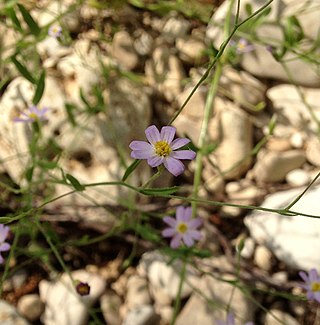
Boltonia asteroides, the white doll's daisy, false chamomile, or false aster, is a species of plant native to the United States and Canada. It is found primarily in the Mississippi Valley and Great Plains from Saskatchewan south to Texas and Florida, with isolated populations in the eastern United States. Reports of the species in New England, New York, and the Pacific Northwest appear to be introductions.

Boltonia diffusa, the smallhead doll's daisy, is a North American species of plants in the family Asteraceae. It is native to the United States, primarily the states along the Gulf of Mexico from Texas to Florida plus the lower Mississippi Valley from Louisiana to Illinois. There additional populations in the eastern United States as far north as Virginia.

Berlandiera is a genus of flowering plants in the family Asteraceae.

Chaetopappa is a genus of plants in the family Asteraceae which are known generally as leastdaisies.

Erigeron strigosus is a species of flowering plant in the family Asteraceae known by the common names prairie fleabane, common eastern fleabane, and daisy fleabane.

Helenium amarum is a species of annual herb in the daisy family known by the common names yellowdicks, yellow sneezeweed, fiveleaf sneezeweed, and bitter sneezeweed. It is native to much of the south-central United States and northern Mexico, and it is present elsewhere in North America, Australia, and the West Indies as an introduced species.

Houstonia longifolia, commonly known as long-leaved bluet or longleaf summer bluet, is a perennial plant in the family Rubiaceae. It can be found throughout most of the Eastern United States and Canada. It has been reported from every state east of the Mississippi River except Delaware, plus North Dakota, Minnesota, Missouri, Arkansas and Oklahoma, with isolated populations in Kansas and Texas. Also, all Canadian provinces from Quebec to Alberta. It prefers upland woods in poor, dry, often sandy soil.

Chaetopappa ericoides is a species of flowering plant in the family Asteraceae known by the common names rose heath and heath-leaved chaetopappa. It is native to the southwestern and western Great Plains regions of the United States, plus northern Mexico. It is found in California, Nevada, Arizona, Utah, New Mexico, Colorado, Wyoming, Texas, Oklahoma, Kansas, Nebraska, Chihuahua, Coahuila, Sonora, Durango, Zacatecas, San Luis Potosí, and Nuevo León.

Oenothera macrocarpa, the bigfruit evening primrose, Ozark sundrops, Missouri evening primrose, or Missouri primrose, is a species of flowering plant in the evening primrose family Onagraceae, native to northeast Mexico and the south-central United States, where it is found in calcareous prairies and limestone outcrops.
Chaetopappa hersheyi is a rare perennial plant species of plant called Hershey's cliff daisy, in the sunflower family. The epithet "hersheyi" honors the plant's discoverer, Arthur LeRoy Hershey, who collected it in 1944. It was formally described by Sidney Fay Blake in 1946.

Symphyotrichum subulatum, commonly known as eastern annual saltmarsh aster or, in Britain and Ireland where it is naturalized, annual saltmarsh aster, is an annual plant in the family Asteraceae native to the eastern United States and the Gulf Coast to Texas. The species grows primarily in coastal salt marshes, although in the Ozarks it occurs as a non-marine weedy variety.

Chaetopappa bellidifolia , called the Edwards lazy daisy, or whiteray leastdaisy, is a North American species of plants in the family Asteraceae. It has been found only in central Texas, largely in the Edwards Plateau.
Chaetopappa bellioides, called the pretty lazy daisy, or manyflower leastdaisy, is a North American species of plants in the family Asteraceae. It native to northern Mexico and to the Rio Grande Valley in western and southern Texas.
Chaetopappa effusa, called the spreading lazy daisy, or spreading leastdaisy, is a North American species of plants in the family Asteraceae. It has been found only in Texas, largely on the Edwards Plateau.
Chaetopappa imberbis, called the awnless lazy daisy, or awnless leastdaisy, is a North American species of plants in the family Asteraceae. It has been found only in south-central Texas.
Chaetopappa parryi, called the Parry's lazy daisy, or Parry's leastdaisy, is a North American species of plants in the family Asteraceae. It is native to northeastern Mexico and to the Big Bend region of western Texas.

Erigeron bellidiastrum, the western daisy fleabane or sand fleabane, is a species of fleabane in the family Asteraceae. It is native to northern Mexico and the western and central United States.

Hymenopappus artemisiifolius, the oldplainsman, is a North American species of flowering plant in the daisy family. It has been found only in the south-central United States, in Texas, Arkansas, and Louisiana. Its natural habitat is in sandy soils of prairies and open woodlands.

Hymenopappus scabiosaeus, the Carolina woollywhite, is a North American species of flowering plant in the daisy family. It grows in the central and southeastern United States, primarily on the Great Plains an on the Coastal Plain of the Southeast. There are also isolated populations in Illinois and Indiana as well as in the state of Coahuila in northern Mexico.

Symphyotrichum divaricatum is an annual and herbaceous plant commonly known as southern annual saltmarsh aster. It is native to the southern United States and some northern states of Mexico.















